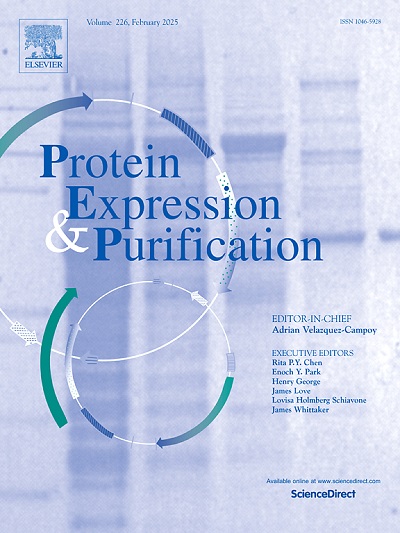Isolation, expression, and characterization of potato (Solanum tuberosum) GH family 17 β-1,3-glucanase (Stglu) for exploring its potential as an antifungal agent
IF 1.4
4区 生物学
Q4 BIOCHEMICAL RESEARCH METHODS
引用次数: 0
Abstract
Plant glucanases, including potato glucanase, are pivotal in biological processes such as cell growth, development, and defense against pathogens. These enzymes hold substantial promises in biotechnological applications, especially genetic engineering for enhancing crop disease resistance and stress tolerance. In this study, from Solanum tuberosum, glycosyl hydrolases family 17 (GH-17) β-1,3-glucanase (Stglu) was cloned, expressed, characterized and its antifungal activity was evaluated. The gene was isolated from infected potato plants and cloned into the pDrive and subsequently into the pET32a (+) protein expression vector. Sequence analysis revealed a 1044 bp open reading frame encoding a 347 amino acid protein with an anticipated molecular weight of 38 kDa and a signature motif (-IEIIVSESGWPSEG-) of the GH-17 family. The recombinant β-1,3-glucanase (Stglu) protein was expressed in E. coli Rosetta-gami 2 (DE3) cells. After recovery from inclusion bodies using urea buffer solubilization and refolding by dialysis, expression of Stglu protein was confirmed by Western blot analysis using an anti-His antibody. Enzymatic assays were performed to characterize β-1,3-glucanase activity which showed its maximum activity at pH 7.0 and 37 °C. Plate assays for substrate specificity showed that the enzyme hydrolyzed azo-barley β-glucan and laminarin. The metal ions strongly affected the enzyme's activity; Ca2+ acted as a weak activator. Plate assays further indicated the antifungal activity of Stglu against the plant pathogen Fusarium solani, showing a biotechnological potential tool in controlling fungal pathogenicity in crop plants.
马铃薯(Solanum tuberosum) GH家族17 β-1,3-葡聚糖酶(Stglu)的分离、表达和鉴定及其抗真菌潜力的研究
植物葡聚糖酶,包括马铃薯葡聚糖酶,在细胞生长、发育和防御病原体等生物过程中起着关键作用。这些酶在生物技术应用中具有巨大的前景,特别是在提高作物抗病性和抗逆性的基因工程中。本研究从龙葵中克隆、表达、鉴定了糖基水解酶家族17 (GH-17) β-1,3-葡聚糖酶(Stglu),并对其抗真菌活性进行了评价。该基因从受感染的马铃薯植株中分离出来,克隆到pDrive中,随后克隆到pET32a(+)蛋白表达载体中。序列分析显示一个1044 bp的开放阅读框编码一个347个氨基酸的蛋白,预计分子量为38 kDa,具有GH-17家族的特征基序(- ieiivsesgwpseg -)。重组β-1,3-葡聚糖酶(Stglu)蛋白在大肠杆菌Rosetta-gami 2 (DE3)细胞中表达。在包涵体中使用尿素缓冲液增溶和透析重新折叠后,用抗his抗体进行Western blot分析,证实Stglu蛋白的表达。酶法测定β-1,3-葡聚糖酶活性,结果表明,β-1,3-葡聚糖酶在pH 7.0和37℃条件下活性最高。平板检测底物特异性表明,该酶可水解偶氮大麦β-葡聚糖和层粘连蛋白。金属离子对酶的活性影响较大;Ca2+作为弱激活剂。平板实验进一步证实了Stglu对植物病原菌枯萎病(Fusarium solani)的抑菌活性,显示了其在控制作物真菌致病性方面的生物技术潜力。
本文章由计算机程序翻译,如有差异,请以英文原文为准。
求助全文
约1分钟内获得全文
求助全文
来源期刊

Protein expression and purification
生物-生化研究方法
CiteScore
3.70
自引率
6.20%
发文量
120
审稿时长
32 days
期刊介绍:
Protein Expression and Purification is an international journal providing a forum for the dissemination of new information on protein expression, extraction, purification, characterization, and/or applications using conventional biochemical and/or modern molecular biological approaches and methods, which are of broad interest to the field. The journal does not typically publish repetitive examples of protein expression and purification involving standard, well-established, methods. However, exceptions might include studies on important and/or difficult to express and/or purify proteins and/or studies that include extensive protein characterization, which provide new, previously unpublished information.
 求助内容:
求助内容: 应助结果提醒方式:
应助结果提醒方式:


